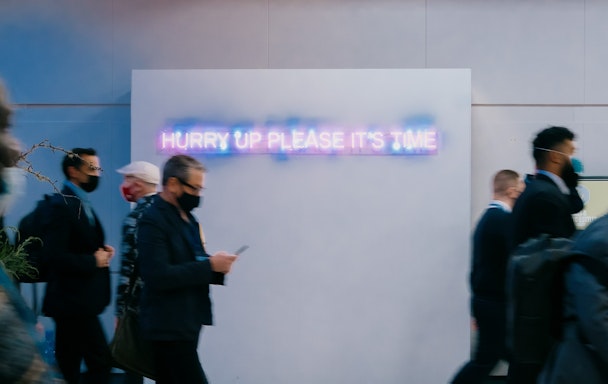Inside Cop26: the event’s organizers on ‘the largest game of Tetris ever’
Cop26, the 26th United Nations Climate Change conference, is over. Its success as a conference is up for debate, but its success as an event is another matter. We sat down with Identity, the agency tasked with delivering one of the most closely-watched conferences in history, to talk about delivering a behemoth event in a global pandemic, the sustainability standards of an organization that sets the sustainability standard, and the future of live events.

Inside the Cop26 event with events agency Identity / Image courtesy of Identity
Cop26’s output, the Glasgow Climate Pact, did not achieve nothing, with new commitments on cutting back on burning coal and a plan to agree next year on measures to reduce carbon emissions. But few are calling this a resounding success, with its compromise agreement being described as an exercise in “kicking the can down the road.”
But there is at least one group that will be celebrating the event without reservation: its organizers. East Sussex-based events agency Identity have been in the business for over 20 years, but in an industry where a few titans have long dominated, it’s been happy to describe itself as “a new kid on the block” until a recent run of growth saw it attract major talent and win global projects, including this year’s G7 summit. But the challenges of Cop26 were, as we’ve come to say, unprecedented.
The show must go on
Identity had pitched for the work when Cop26 was originally scheduled for 2020 – the conference was delayed and the tender process canceled in what chief exec Michael Gietzen describes as “one of the darkest days of all of our lives.” Who can say whether it would have been successful that time round – but it did win the work 12 months later, in April of this year.
That left four months for planning and development until work started on the Glasgow site in August.
Back in April of 2020, few would have imagined that preparations a year later would still be dominated by Covid-19. “What makes this year and this project so special is the lens of uncertainty that shrouded elements of it,” says Gietzen.
The pandemic “decimated” the events industry, wrought havoc with the supply chain, caused a brain drain in the sector and curtailed international travel. It also introduced rafts of regulations that varied from country to country. Throughout, says head of major events Simon Dunnell, that meant “designing for the worst and hoping for the best.”
Uncertainty existed at a foundational level too, with continued “scrutiny of the event itself – whether it should go ahead.” That meant initially preparing two separate tenders, one for a socially-distanced event and another for business-as-usual – ultimately, it delivered something in between.
A new kind of event
‘In between’ does not mean ‘easy’ though. “Once you start applying the Covid lens to the spatial planning of a project, you start doubling the amount of space you need for every element,” says Dunnell. 1.5m of socially distancing across the site meant doubling all meeting room sizes. With 300 meeting rooms, that’s no mean feat.
The event’s 40,000 IRL attendees were distributed around a site the size of 28 football pitches, taking up the entirety of Glasgow’s SEC events center and adding some 50 purpose-built structures. Dunnell calls the task of configuring that physical space “the largest game of Tetris ever.”
Accommodation, transport and security are separate contracts and the venue provides some infrastructure, but everything else was Identity’s responsibility. Temporary buildings, additional power, lighting, rigging, room dressing, signage, creative and co-ordination required not just most of their 200-strong management team (scaled up to 400 for the project), but 5,000 on-the-ground personnel and 1,000 volunteers.
Extra cleaners, ventilation and UV air cleaning were all necessary to reduce transmission risks. Some attendees couldn’t attend in person. “If someone couldn’t attend because of Covid or travel restrictions, we needed to make their experience of the event on a par with those within the main meetings, and with the same functionality,” says Dunnell. That meant turning 2,500 meetings hybrid, with parallel complexities online. “All of the physical attributes around security and access had to be replicated in the virtual world.”
Baked-in sustainability
The parties convening for Cop26 make up, quite literally, the highest climate authority in the world, so sustainability was a singularly important consideration. Sustainability in this area means, above all else, re-usability. Mike Conaty, executive producer and sustainability lead, calls this a lifecycle approach: “What materials are we using and how can we repurpose those at the end of the event?”
Here, Conaty becomes effusive on a surprising topic – carpets. “We’ve got something like 15,000 square meters of carpets going to a social enterprise in Glasgow, repurposing them for social housing,” he says. “The design decision was to go higher quality ... making it better suited for end repurposing. We went for a light gray rather than a United Nations blue, so that people would be more likely to want it in their houses.” Similar arrangements have been made with, for example, £1m worth of Ikea furniture.
Working with local suppliers was key, especially at a moment when many suppliers’ businesses had been decimated by the pandemic. Carbon monitoring and measurement across that supply chain, as you can imagine, was essential; this was the first Cop event held under PAS 2060, the international standard of climate neutrality. “Reporting and data is key,” says Gietzen. “Everyone says they’re having green events, but there isn’t actually a piece of software that can track that.” To that end, Identity adapted a database tool often used in the construction industry (and hopes that such tools will soon become standard).
What now?
The sheer complexity of delivering an event of this scale is dizzying – and, presumably, rather stressful? “When you have 120 world leaders, mixed with two royal households and a star-studded guest list from David Attenborough to Leonardo DiCaprio to Jeff Bezos, that keeps you up at night,” says Gietzen. “You have to ensure their safety, and you have to make sure you represent the UK in the best way possible. That’s incredibly stressful, but it’s also the thrill. It’s why we do what we do.”
And where does one go from here – what’s the next big event? “Christmas. Just eating and drinking as much as we can over the Christmas period.”
Content created with:

Identity
Identity is a global, full service creative production agency with over twenty years proven pedigree in the delivery of major, high profile events in the UK, and...
Find out more
